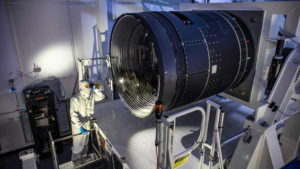The Largest digital camera of world has become an innovative instrument in the mission to understand the mysteries of the universe. This technological marvel is prepared to explore the mysterious forces and cosmic phenomena within the dark universe.
This Mega Digital Camera is an incredible advance in astronomical observation because of its unmatched size and accuracy. It can detect long-mysterious objects like dark matter and dark energy because of its advanced sensors and imaging capabilities.
Like the hidden side of space, the dark universe is packed with secrets just waiting to be unlocked. It is the place where entities that are invisible to the naked eye or to ordinary telescopes, such as dark matter and dark energy, are hiding.
However, researchers have now created the largest digital camera of world to date, like a massive eye for space. With millions of tiny sensors, this camera is incredibly powerful and can catch details never seen before, even distant galaxies.
Consider this for this Mega Digital Camera: when you snap a picture with your phone, you capture the moment in front of you. However, this enormous space camera allows scientists to magnify far-off stars, galaxies, and even enigmatic objects like black holes. It is close to creating a crystal-clear image from an out-of-focus shot.
The Particulars of the Largest digital camera of world

Equipped with a ground-breaking 3,200-megapixel LSST camera, the Vera C. Rubin Observatory is about to set out on an incredible mission. With the potential to create what astronomers are calling the greatest movie of all time and the most informative map of the night sky ever assembled, this incredible device is composed to capture the essence of the cosmos like never before.
Envision an unmatched cinematic masterwork playing out in front of our eyes; Mega Digital Camera captures the celestial dance of stars, galaxies, and cosmic occurrences in all their splendor and richness. The LSST camera will be able to record space-time moments with remarkable sensitivity and resolution, providing a finely detailed view of the universe’s dynamic dynamics.
However, the goals of the Largest digital camera of world go beyond visuals. Its goal is to compile an extensive map of the night sky, a wealth of astronomical information that will transform our knowledge of the universe. This enormous map’s every pixel will contain insightful information that will lead astronomers on a quest to discover the universe’s mysteries.

With the ability to map out the distribution of dark matter and monitor comet and asteroid movements, the LSST camera will be a lighthouse of discovery, answering some of the deepest issues in astrophysics. It will open the door for innovative studies that will spur discoveries for upcoming generations.
But shooting attractive images isn’t the only thing this Mega Digital Camera can do. It is a tool that scientists use to research and comprehend the universe more abundantly. They can discover more about the formation of galaxies, the composition of dark matter, and the behavior of the cosmos on the biggest scales by gathering an enormous amount of data about space.
Scientists are therefore preparing to investigate the deepest recesses of space and discover its greatest mysteries with the help of this Largest digital camera of world. This camera is paving the path to solving the universe’s mysteries during an exciting period for space research.
Nevertheless, let us understand the dark universe and its fundamentals. The enormous and enigmatic parts of the cosmos that are not directly viewable with conventional telescopes or devices are referred to as the dark universe. It includes dark energy and dark matter, the two primary phenomena.

Dark matter is a type of stuff that is unseen and unnoticeable to the human eye using standard techniques since it does not emit, absorb, or reflect light. Galaxies and galaxy clusters are examples of visible matter that is gravitationally affected by dark matter, despite its elusive nature. Through galaxy rotation curves, gravitational lensing, and other indirect data, scientists deduce its existence. It is thought that dark matter makes up a large amount of the universe’s total mass, substantially more than visible matter.
Dark energy is a theorized type of energy that saturates space and pushes the universe’s faster expansion. Dark energy fills the voids between galaxies and other structures, unlike normal matter and radiation, which cluster in these structures. Cosmic microwave background radiation and studies of far-off supernovae were used to deduce its existence. Even though dark energy makes up a sizable fraction of the universe’s overall energy density, its exact nature is still one of the greatest mysteries of modern cosmology.
Dark energy and dark matter together make up the majority of the dark universe, which is an exciting area of astrophysics and cosmology.













